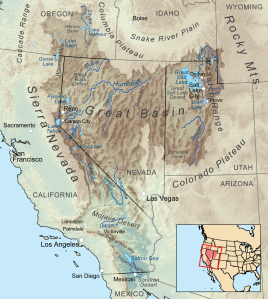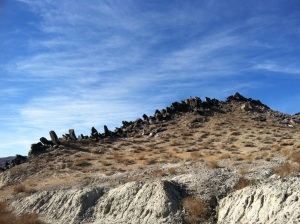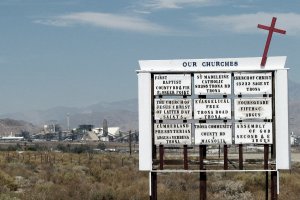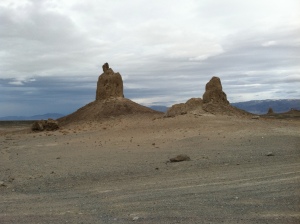While driving through San Bernardino County, California on the way to Death Valley in the spring of 2012, my father and I saw an unusual sign. It appeared to be a sign for a park or monument but it didn’t seem to point to any road and it said only one word:
“PINNACLES”
Confused, we stopped the car and looked around. We saw an unusual rock formation by the side of the road. Were these the pinnacles?
A little bit of research revealed that the real pinnacles were much stranger and more beautiful than I ever would have guessed. And on a recent return trip I had the pleasure of seeing them up close.
The Trona Pinnacles are a geological oddity situated in a bleak stretch of the Mojave Desert outside of the town of Trona, California. Over 500 strange limestone formations, some over a hundred feet tall rise abruptly from the uninterrupted plane of a huge mineral flat. These strange rock towers are so otherworldly that they’re used as a stand-in for alien worlds in film and television every year. But where did they come from?
The nearby town of Trona sits on the edge of the cruelly and deceptively named Searles Lake, a large dry lake bed that is a remnant of an age when southeastern California had a considerably different climate than today. Much of southeastern California is composed of “basin and range” topography which is distinguished by a series of valleys divided by narrow mountain ranges. In the southwestern United States these basins (and ranges) are arranged roughly north to south, making huge swaths of this country not unlike a very large washboard. This physiography is caused by tectonic movement which I won’t pretend to fully understand but which involve fault lines pulling apart and cutting deep valleys into the earth while leaving spectacular twisted and diagonal strata throughout the region. Searles Lake lies at the bottom of one such basin (Searles Valley) which also lies in the enormous endohreic region of the United States called the Great Basin.

The Great Basin is a collection of endohreic watersheds, meaning areas of drainage which do not flow to the sea but rather dry up in arid regions, seep into underground aquifers or collect in salt or alkali lakes. Searles Lake is an alkaline flat, a huge playa where minerals collect from mountain runoff that evaporates in the bottom of the valley. Trona was founded as a company-owned town to house workers for a borax mining operations. Today the town’s economy still relies on mineral extraction from the lake bed. The chances of Searles Lake ever receiving enough rain to become permanently wet are basically nil; the basin and range physiography creates a series of successive rain shadows with each mountain range that block moisture from reaching the interior, creating a permanent imbalance between the area’s enormous evaporative potential and its tiny annual rainfall. But things were not always quite so dry in San Bernardino County. In fact, a mere 20,000 years ago Searles Lake was one of many inland seas throughout the Great Basin, including nearby Panamint Valley and Death Valley and extending all the way north to distant Mono Lake. (As an interesting sidenote, Death Valley’s former body of water, called Lake Manly, left behind more than a few traces to this day, including a species of fish which still survives in Death Valley’s Salt Creek, the Death Valley pupfish.) This ancient body of water is the source of Trona’s enigmatic Pinnacles.

The Pinnacles are composed of tufa, an unusual mineral formation. Tufa is calcium carbonate, also known as limestone but which has formed in an unusual way. Tufa spires form under alkaline lakes where groundwater high in calcium seeps into the lakebed. The calcium in the groundwater reacts chemically with the carbonate in the lake and precipitates over eons to form strange unearthly deposits which we call tufa pinnacles. These pinnacles remain invisible beneath the surface unless the water is drained, as it was in Mono Lake during the 1970s. Mono Lake was largely drained to feed Los Angeles’s water needs, which revealed tufa pinnacles beneath the surface much like those in Trona. Conservation efforts wisely saved Mono Lake from total destruction but even today its tufa formations are visible and make the lake an oddity and tourist attraction.
Searles Lake gradually dried out at the end of the Pleistocene leaving several successively smaller groups of pinnacles behind as the water vanished. By the time humans came to Searles Lake it was only a dry expanse of caustic minerals, but these strange stone towers have served as a monument for California’s inland seas ever since. Enjoy some pictures of these strange and beautiful formations.







